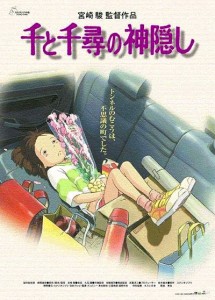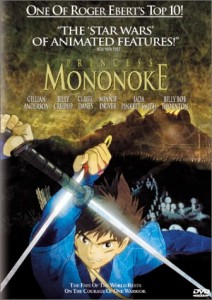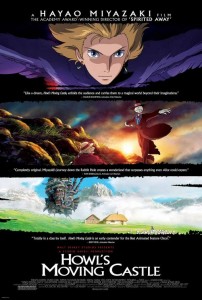Far more Americans saw the clips from Spirited Away shown just before its Academy Award was announced than will ever see the movie. Despite anime’s extreme popularity in certain US markets, anime films have almost universally underwhelmed at US box offices and receive little general exposure in the states. What did it take for Spirited Away to attain its relative prominence in the American market and, if any, what effect has its story tell us about the possibilities for wide scale US distribution of anime films in the States?
The Story of Spirited Away
 Spirited Away was a wild domestic success by any metric. Released in Japan in July of 2001 to a remarkably positive reception, by 2002 a sixth of the Japanese population had seen the film. A favorite among parents and children alike, it went on to gross approximately $250 million in Japan, b
Spirited Away was a wild domestic success by any metric. Released in Japan in July of 2001 to a remarkably positive reception, by 2002 a sixth of the Japanese population had seen the film. A favorite among parents and children alike, it went on to gross approximately $250 million in Japan, b
reaking the domestic box office record snagged from Miyazaki in 1997 by Titanic and making that fabled director the country’s most successful to date by the numbers.[i] Many attributed the success to the admittedly exaggerated rumors of Miyazaki’s immanent retirement.
Not just a popular blockbuster, Spirited Away also went on to garner international critical acclaim. Rotten Tomatoes gives the film a score of 96%, and among the site’s “Top Critics,” the score is 100%.
It is also well decorated with many international awards from film festivals and critical organizations. Among its most notable awards are the
Best Picture from Japan’s Academy Awards, a Golden Bear – Berlin International Film Festival’s all-around top
prize – and the second Oscar ever awarded for Best Animated Feature. That Oscar made Spirited Away the first anime film to win an American Academy Award and it is still the only non-English speaking animation film to do so.
 In September of 2002, Disney finally released a dubbed – and otherwise uncut – version of the film in the US. At this point, Spirited Away was the first film ever to make $200 million before being released in US theaters. Under the personal supervision of Pixar’s John Lasseter, who directed Toy Story and has since produced almost all of Pixar’s biggest hits, there was some hope that Spirited Away might take off in the states.
In September of 2002, Disney finally released a dubbed – and otherwise uncut – version of the film in the US. At this point, Spirited Away was the first film ever to make $200 million before being released in US theaters. Under the personal supervision of Pixar’s John Lasseter, who directed Toy Story and has since produced almost all of Pixar’s biggest hits, there was some hope that Spirited Away might take off in the states.
Those hopes were dashed. Disney opened the film in about 100 theaters, most of which were art houses. By comparison, most first-tier Disney films will open in 3000+ theaters. Initially hopeful sales quickly weakened, and the film never caught on. While the surprise Oscar nod provided the opportunity of a medium-scale, 700-theater distribution, people did not turn out. Ultimately the film only grossed a disappointing $10 million in the US despite a long run of about a full year. [ii]
Anime in the US
That Spirited Away was not selling was not because Americans were not buying anime (Or manga., as Charles investigated). During the same year Spirited Away came to the US,” royalties and merchandising from Japanese anime in America reached a record $4.35 billion, three times greater than Japan’s steel exports to the United States.”[iii] Similarly, around 40% of the Cartoon Network’s programming was at that point Japanese anime or anime inspired. And people were watching this material: “Cartoon Network’s late night Adult Swim segment, which heavily features Japanese anime is [in 2004] the most watched cable block in its time slot for men between 18-34, beating out Jon Stewart’s Daily Show, the Tonight Show, and Late Show with David Letterman.”
This year had been the peak of a recent upsurge in American interest in anime. In 2003, two anime shows had made their way on to the list of top ten children’s programming, according to the Neilson Ratings. A decade before, no anime shows were or had been on that list, and since anime has often remained present on it. [iv] [v]
Even so, anime generally has carved out little ground at the box office. According to Boxofficemojo.com, the Pokemon franchise alone is responsible for about two-thirds of the total gross revenues from anime films in the US at the box office. All anime films that have ever been shown in the US combined grossed the remaining figure – about $70 million, a typical return for any single Hollywood film. Miyazaki’s previous mega-hit in Japan and mega-flop domestically, Princess Mononoke, still retains a spot on the all-time top-ten of anime list, even with its disappointing $2 million return. So what’s going on here?
“Stepchild Syndrome”
In a piece for the San Fransisco Chronicle, G. Allen Johnson argues that Hollywood itself is responsible for the failure of Asian films – and not just anime – in America. “They seemingly don’t know what to do with the Asian films they buy,” he writes.[vi]
He argues that American distributors who pick up the rights to Asian films have not yet figured out how to effectively get them into the American marketplace. Past failures, like Princess Mononoke that had an expensive cast of A-list voice actors for its dubbing and still came up short, keep studios wary about taking risks. As a result, distributors often open the films with little or no effective advertizing strategy, which results in US flops of major Asian hits.
Spirited Away, as a case study, suggests this argument does indeed tell part of the story. While anime powerhouses like Studio Ghibili are very adept at making movies, they do not have the international marketing or distribution muscle available to organizations like Disney. In 1996, Tokuma, Ghibli’s parent company, signed a historic distribution deal with Miyazaki that would have tremendous effects on the possibilities of anime blockbusters in the US in the coming decades. This arrangement was called the Disney-Tokuma deal, or just “D-T.”
When looking for a distributor, the renowned and respected Miyazaki was in a seller’s market and in a position to make demands. After a bad experience in which a worldwide distributor changed one of his films in a way he did not approve of, Miyazaki insisted on preserving unchanged the visual and musical elements of his films abroad. Distributors would have the option to add subtitles or dub the films. Additionally, Miyazaki, who generally is seen as somewhat anti-commercial or somehow above commerce, would not concede merchandizing rights, likely in an attempt to keep his images from winding up on backpacks, action figures and in spin-off television shows. Disney was the only company that would agree to these provisions. In exchange, they requested the extremely lucrative domestic distribution rights to Studio Ghibli films. After agreeing, they signed the deal.[vii] [viii]
Some worried this D-T was a ploy for Disney to place itself in a position to suppress international rival on its home turf, and that since this deal Disney has intentionally neglected these films in order to avoid undercutting its own (more expensive) darlings.[ix] [x] While this consideration may have been a part of the calculus, D-T created a very specific incentive structure for Disney that did not encourage large expenditures on US promotion of Ghibli films.[xi] By far the most consistently lucrative element in this deal for Disney is the Japanese distribution rights for VHS and DVD releases of Miyazaki’s films, which all became multimillion-unit bestsellers in Japan. “The North American distribution rights of the films were just the icing on top of this. And that’s where the trouble began.”[xii]
The major issue is that, without merchandising rights, the advertizing calculus is skewed. With most films, advertizing dollars are further recouped in spin-offs and merchandizing that, in this case, would not be available to Disney. With historically miniscule and uncertain box office grosses being the only return on investment possible – and no ability to safeguard itself by editing the film before distributing it – Disney was not apt to pump much into the marketing budgets of one of these films. Without such a budget, the likelihood of its doing well was very slim. One writer calls this the “stepchild syndrome.”[xiii]
There was hope that after Spirited Away won an Oscar, anime would experience an emergence of popularity in American theaters and subsequent marketing funding. This has not been born out, either in box office receipts or in Academy Awards. Two interrelated reasons for this appear to be: 1) stubborn American notions about age and animation that make much of anime incompatible with the ways the American audience watches film and 2) the pervasive “foreignness” associated with anime films.
Assumptions about Age
One cannot discuss American consumption of anime without considering how Americans consume their own animation. Over the last 60 years, Disney has had wild success in creating a rock solid perception in the American psyche that animation is for children. Pokemon fit into that paradigm, and Americans were able to consume it voraciously. In other places, such as in Adult Swim, anime offered an opposite alternative that was still in conversation with this idea: those late night cartoons are consumed by adults but not by children. In all of American animation, there are few exceptions to this rule.
This dynamic is reflected in the nature of the area in which anime films do perform well in America: the art house theater. A recent exhibit at the Academy of Motion Picture Arts and Sciences entitled, “ANIME! High Art – Pop Culture,” was one of several recent exhibitions to take anime out of the theater and move it into a gallery space. Likely, the primary allure of anime in this context is a somewhat nostalgic appreciation for their hand drawn “realness” in an era when most animated films are made by computers. A Wharton business school article suggests that the high art connotations that anime films have taken on currently hold back the genre from universal appeal: “Anime appeals to a mostly niche market of affluent, well-educated viewers, the type who would admire small, independent films. ‘From a mass-market perspective, it doesn’t seem as accessible. Even though it is visually stunning and attractive, the storytelling can seem too high-brow for traditional family-fare animation.’”[xiv] The establishment of anime in art houses, which children do not frequent, limits the types of people who wind up exposed to these films.
“Foreignness”
In this art house context, where a sense of “foreignness” is likely seen as a positive characteristic, it did not matter that Disney was unable to (or Miyazaki chose not to) “localize” his films to make them “less Japanese.” Like almost all anime, Spirited Away is distinctly Japanese, and so to make it less so would be very difficult. Much of its code system is based in Japanese folk lore or Shinto tradition, requiring a familiarity with Japan in order to fully decode the text. “The truth is, we make our movies for Japanese audiences,” said Toshio Suzuki, president of Studio Ghibli.[xv]
“Miyazaki is incredible and the critics love him, but his movies are still just too Japanese specific for mass appeal,” said Alfred Kahn of 4Kids Entertainment, the group that brought Pokemon to the States.[xvi] Some research suggests that this statement may apply generally to anime, and that this foreignness is at the root of why anime may not have the same wide-scale appeal in the US as it does in Japan. One student, in his masters in communications thesis, directly took on the issue of why Japanese children and adults can enjoy anime while, in America, this is generally not the case. After using study groups of US residents with some familiarity with anime to gauge the general culturally -held perspective on the form, he wrote that in “anime contains cultural, adult, and mature issues that many western audiences are not used to viewing with their children. It is possible that its content will mean it is never fully accepted by the west. In much the same way as the west as been accused of cultural imperialism in the past, it is possible that same label may be placed on anime as its content conflicts with traditional western values.”[xvii] So long as films like Spirited Away that Westerners can happily take their children to see are the exception, rather than the rule, in anime, the genre will face a difficult time taking off in a market that begrudgingly insists animation is for children alone.
Workarounds
Hollywood is trying several techniques to get around these issues. The first, which appears not to work, is to attempt to relate particular anime films to Western texts through marketing and casting. The second is to simply trash the original text and start over with a live-action remake.
The promotional materials surrounding these films exemplify the first approach. The press release for the Spirited Away premier emphasized its being culturally Japanese while evoking classic Western favorites, like The Wizard of Oz or Sleeping Beauty. Similarly, Princess Mononoke’s poster features a New York Post quote saying that film is ‘the Star Wars of animated features!” In Howl’s Moving Castle, a similar message comes across: “Miyazaki’s journey down the Rabbit Hole creates a wonderland that surpasses anything even Alice could expect.”
The studio press kit included images with markedly “Japanese” signifiers, like dragons or Japanese archetechture, while emphasizing the cast and producers of the English-language version of the film. This included the popular American child actress Daveigh Chase, as well as John Lasseter, who assumed a status-as-author in America and whose name was very closely associated with the film in much American media. The same strategy was attempted with Princess Mononoke, with its A-list cast.
Trailers for the Spirited Away prominently branded it as a Disney production first and foremost, before giving way to a world in which there is Kanji and other distinctly Japanese signifiers. Otherwise, it highlights the film’s awards, playing to the Art House audience. This branding as a “Disney product” proves significant in the English language version in at least one major way: while they could not alter the images in the film, Disney’s dubbing does add a final line of dialogue that considerably changes the tone of the ending of the film to make it much more optimistic and American-audience friendly. In general, it would be a mistake to say that these films are delivered to American audiences as pure “Japanese” products; they are mediated texts changed by the institutions they pass through in order to appear more familiar to an American audience.
Even so, most people did not watch them. The other significant Hollywood technique is remaking anime films into live action films. The clear advantage of this approach for Hollywood is that it knows its audience and is excellent at delivering to it exactly what it wants and will pay for. Many blogs are calling the recent uptick in these kinds of films the “Anime Invasion” or, more bluntly, Hollywood’s new cash cow. Recent films like Speed Racer, The Matrix (said to be based on Akira) and Transformers exemplify this trend, and we should expect to see many more of these remakes in the future.
Conclusion
In whatever the form, it is clear that Anime will continue to have a remarkable effect on the American cinema market in the coming years. There are not many film production studios outside the US that compete with Hollywood for American eyes, especially in the world of popcorn movies. That Studio Ghbili is even on the radar is a tremendous testament to the stature of Japan’s Gross National Cool. This approach does not even address the aesthetic influence anime is currently exercising all over the world in animation and film studios.
The D-T deal is a tremendous roadblock towards the wide-scale release of anime films in the US. When it is abandoned or altered, when another Miyazaki rises to the spotlight, or when audiences convince Disney that anime will work in the United States, the genre will have a much better fighting chance here.
Discussion Questions:
In terms of soft power, which is more significant: that fewer audiences see original Japanese films or that more see Japanese-influenced filmmaking?
At this point, it is difficult to predict the future of anime in America. While it is very popular in certain areas, Americans seem reluctant to adopt the foreign form in its own cultural productions. Do you see this changing in the coming years? Is anime on its way in or on its way out?
I am arguing that the foreignness of these products is actually a turn-off to the general American consumer. This seems to run opposed to McCray’s argument that the “Japaneseness” of Japanese products is what draws the consumer in. Do you buy my argument? Are these contradictory stances?
If you do buy my argument, could it be that film is one area in which we have traditionally dominated and now we do not want Japanese influence because of some sense of cultural insecurity?
[i] “Spirited Away – Extras and Trivia.” Eternal Promise: The Haku of Spirited Away Fanlisting. N.p., n.d. Web. 20 Apr. 2010. <http://haku.winglica.com/spirited_away_extras.php>.
[ii] Box Office Mojo. “Spirited Away (2002) – Box Office Mojo.” Box Office Mojo. N.p., n.d. Web. 21 Apr. 2010. <http://boxofficemojo.com/movies/?id=spiritedaway.htm>.
[iii] Faiola, Anthony. “We’re Playing Their Toons.” The Washington Post 6 Dec. 2004, sec. C: 01. The Washington Post Online. Web. 20 Apr. 2010.
[iv] “Nielsen Ratings/Children’s Television.” The TV IV. N.p., 19 Nov. 2006. Web. 20 Apr. 2010. <http://tviv.org/Nielsen_Ratings/Children%27s_Television>.
[v] Frasier, Alexander Nghiem. “A clash of cultures: Cultural differences within American and Japanese animation.” Masters Abstracts International Vol. 45.5 (2007): 2124. P3. University of Texas at Arlington Library. Web. 20 Apr. 2010.
[vi] Johnson, G. Allen. “Worldwide, Asian Films are grossing millions. Here, they’re either remade, held hostage or released with little fanfare. .” San Fransisco Chronicle 3 Feb. 2005: n. pag. SFGate. Web. 20 Apr. 2010.
[vii] Raymer, William C.. “D–T+10: The Legacy of the Disney-Tokuma Deal.” Online Ghibli. N.p., n.d. Web. 21 Apr. 2010. <http://www.onlineghibli.com/spe/disney-tokuma.php>.
[viii] “The Disney-Tokuma Deal .” Nausicaa. N.p., n.d. Web. 21 Apr. 2010. <http://www.nausicaa.net/miyazaki/disney/>.
[ix] Hairston, Marc. “Spirited Away by Miyazaki.” Frames Per Second Magazine. N.p., n.d. Web. 21 Apr. 2010. <http://www.fpsmagazine.com/comment/spirited.php>.
[x] Johnson, G. Allen. “VIEW / Worldwide, Asian films are grossing millions. Here, they’re either remade, held hostage or released with little fanfare..” San Francisco Bay Area — News, Sports, Business, Entertainment, Classifieds: SFGate. N.p., n.d. Web. 20 Apr. 2010. <http://www.sfgate.com/cgi-bin/article.cgi?f=/c/a/2005/02/03/DDGHFB40EG1.DTL>.
[xi] Hairston, Marc. op.cit.
[xii] Ibid.
[xiii] ibid.
[xiv] “Anime: Japan’s ‘Gross National Cool’.” Knowledge@Wharton. N.p., n.d. Web. 20 Apr. 2010. <http://knowledge.wharton.upenn.edu/article.cfm?articleid=1613>.
[xv] Faiola, Anthony. op. cit.
[xvi] Ibid.
[xvii] Frasier, Alexander Nghiem. “A clash of cultures: Cultural differences within American and Japanese animation.” Masters Abstracts International Vol. 45.5 (2007): 2124. University of Texas at Arlington Library. Web. 20 Apr. 2010.
Entry contributed by Andy Henderson



Although there are lot of factors in Spirited Away that shows ‘Japaneseness’, the model of the scenes is 九処 (in Taiwan). Do you think American people distinguish Japanese things from Taiwanese things in the scene? Or do they confuse Taiwanese scenery with Japanese? Here’s a website that has a comparison between the scene in Spirited Away and the scenery of 九処. http://zapanet.info/blog/item/1668
I would argue that because of anime is slowly growing in popularity throughout America. Yes, historically only certain pockets of society were exposed to the art form, but it would make sense that most foreign phenomena catch on slowly and then begin to pick up speed. In the same way that Sanrio’s Hello Kitty has made it okay for older girls and women to go crazy for a character traditionally reserved for kids, Japanese animation has opened the U.S. to the idea that cartoons and animation are for those of all ages. I believe that as more youth become exposed to foreign cultures, specifically Japanese, they will grow up interested in anime. As long as Japan continues to produce successful anime and manga, I argue that their popularity in the United States will continue to increase.
This is a very interesting question regarding the presence of Taiwanese imagery in the film. Answering based on my experience, I imagine that most Americans do not have the cultural knowledge necessary to differentiate Taiwanese and Japanese architecture. I could not do so when I first watched the film.
However, I should note that when I first saw what I now realize is Taiwanese scenery in the film, I did mark it as distinct somehow. I think I did this for two reasons: the wide, dusty roads and open-air buildings reminded me of a town in an old Western and the facades of the Taiwanese buildings appeared to me to be older than the contemporary Japan of the outside world. As a result, even if Americans could not specifically distinguish the origins of the architecture, I think some may get the point: that this area is foreign in time and place (If that is the point — I am not familiar enough with the way Japanese audiences would have interpreted this to offer more than a guess).
Thank you for the very interesting question!